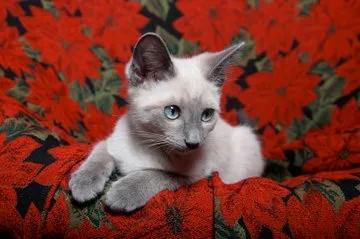Lilac Point Siamese cats captivate cat lovers with their stunning, frosty appearance and theatrical personalities. Often called the “artistes” of the Siamese breed, these pale beauties stand out for their light grey points and china blue eyes. If you’re considering adopting a Lilac Point Siamese, understanding their coloring, history, and care needs is essential for providing the best home.
These cats trace their dilute coloring to Russian Blue influences, giving them a graceful, ballerina-like elegance. Their soft, pale coats and pinkish tones make them one of the lightest Siamese varieties, perfect for those seeking a subtle yet striking pet.
What Makes Lilac Point Siamese Special?
Lilac Point Siamese exude a sense of drama and charm that’s hard to resist. Known for their vocal nature and affectionate demands, they thrive on attention and often “sing” to communicate their needs. Owners frequently describe them as melodramatic performers who know they’re special, insisting on being the center of household activities.
This personality stems from the classic Siamese traits—intelligent, playful, and loyal—but the Lilac Point adds a softer, more refined edge. They form deep bonds with families, especially children and other pets, making them ideal companions for active homes. Regular play sessions with interactive toys help channel their energy, preventing boredom-related mischief.
 Lilac Point Siamese kitten on red background
Lilac Point Siamese kitten on red background
Lilac Point kitten showcasing its frosty grey points against a vibrant red backdrop.
Understanding Lilac Point Coloring
The hallmark of Lilac Point Siamese is their ultra-pale, “frosty” grey points on ears, tail, face, and paws, with a pinkish undertone. This dilute shade is a lighter version of the Chocolate Point, making Lilacs the palest among the four main Siamese colors: Seal, Chocolate, Blue, and Lilac.
Their body fur is cream or magnolia-toned, never pure white, maintaining its lightness lifelong. Eyes gleam with pale china blue, nose leather and paw pads show soft pink hues. Breeders emphasize even dilution—no dark patches—to meet show standards.
Proper care preserves this delicate coloring: Avoid direct sunlight to prevent darkening, and use gentle grooming to keep coats silky. Nutrition plays a key role; high-quality, protein-rich diets support coat health, as recommended by feline nutrition experts.
For similar elegant dilute patterns, explore the blue Siamese, which shares a cool-toned allure.
Lilac Point vs. Blue Point: Spotting the Difference
A common mix-up occurs between Lilac and Blue Point Siamese due to their blue-grey tones. However, Lilacs are silvery-grey and much lighter, while Blues appear slate-grey and deeper.
Compare side-by-side: The Lilac’s points have a frosted, pinkish sheen, contrasting the Blue’s steely intensity. This distinction matters for breeders and buyers—genetics determine the dilute gene responsible for Lilac’s uniqueness.
 Blue and Lilac Point Siamese cats side by side
Blue and Lilac Point Siamese cats side by side
Blue Point (left) and Lilac Point (right) Siamese, highlighting tonal differences.
Health-wise, both are robust, but Lilac Points may inherit Russian Blue traits like dense undercoats, aiding temperature regulation. Routine vet check-ups screen for breed-common issues like dental problems or amyloidosis.
If you’re drawn to traditional Siamese lines, check out the modern Siamese cat for more on evolving patterns.
A Brief History of Lilac Point Siamese
Lilac Points faced skepticism upon emergence, often dismissed as flawed Blue Points or “freaks” in early shows. Persistence paid off: Recognized in the USA in 1955 and Britain in 1960, they gained status as a distinct color.
This journey reflects Siamese’s evolution from Thai temples to global fame. Today, they’re prized in pedigrees, with enthusiasts sharing stories of their “best Christmas gifts ever,” like devoted companion Dottie’s tale.
Related breeds with luxurious coats include the Neva Masquerade Siberian, blending point colors with semi-long fur.
Essential Care Tips for Lilac Point Siamese
To thrive, Lilac Points need a stimulating environment: Vertical spaces for climbing, puzzle feeders for mental exercise, and regular brushing to manage shedding. Feed kitten formulas until 12 months, transitioning to adult food rich in taurine for heart health.
Watch for color preservation—cool baths with cat-safe shampoos maintain frostiness. Annual vaccinations, dental cleanings, and weight monitoring prevent obesity, a Siamese vulnerability.
Drawing from veterinary guidelines like those from the Cat Fanciers’ Association, early socialization ensures well-adjusted adults. Experienced owners note their adaptability to apartments, provided interaction is plentiful.
Discover more dilute beauties in the Himalayan Ragdoll cat.
In summary, Lilac Point Siamese cats offer ethereal beauty, engaging personalities, and rewarding companionship. Their pale elegance and lively spirits make them standout pets—consult a vet for personalized advice and enjoy the journey. Explore our guides on Siamese variations for deeper insights!
References:
- Cat Fanciers’ Association (CFA) Breed Standards.
- “The Book of the Siamese” by Michael Wright (historical context).
- Images courtesy of life-with-siamese-cats.com.
